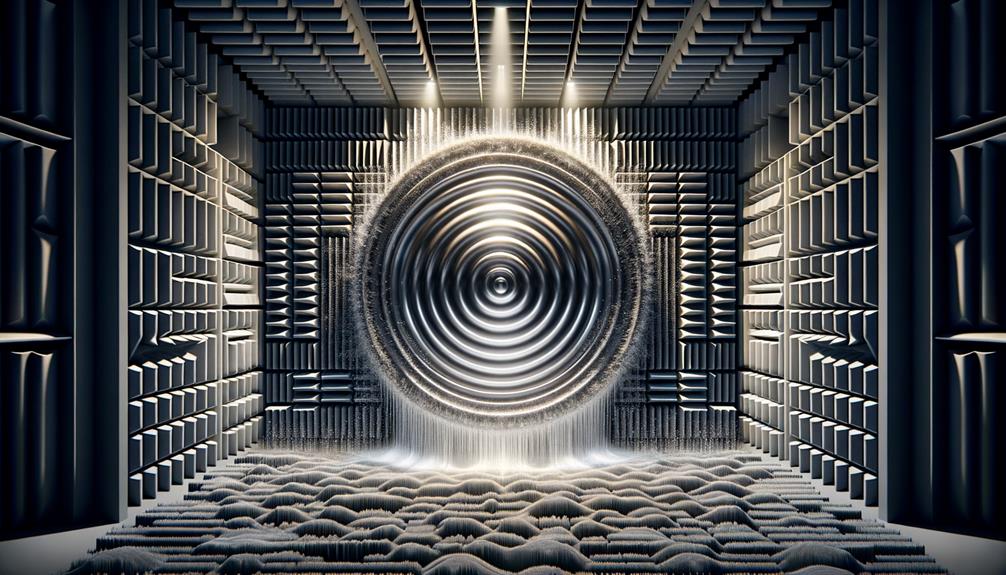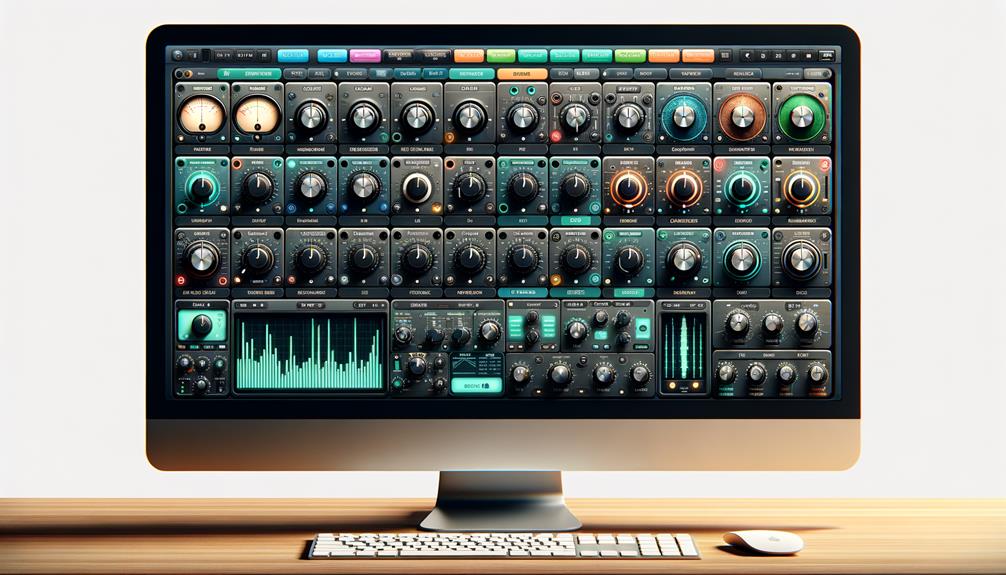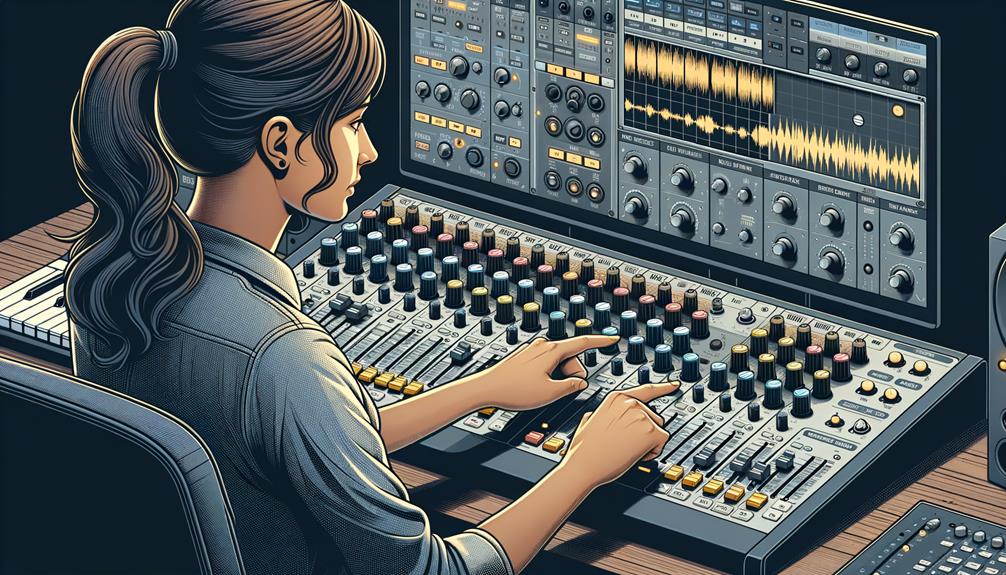No products in the cart.
So, you’ve heard the term ‘plate reverb’ thrown around in the world of audio production, but what exactly is it?
Well, imagine a metal plate suspended in a case, emitting a unique and evocative sound that has been a staple in music production for decades.
But how does it work, and what sets it apart from other types of reverb?
Let’s explore the mechanics and sonic characteristics of plate reverb, and uncover its modern applications and how to choose the right plate reverb plugin for your projects.
Contents
hide
Key Takeaways
- Plate reverb originated in the mid-20th century as a solution for artificial reverberation in audio recordings.
- Plate reverb manipulates a metal plate suspended within a case to generate a spacious and distinctive sound.
- Plate reverb produces a smooth and distinctive sound, adding a metallic glint without harshness.
- Plate reverb enhances the sonic landscape by infusing depth and character into the mix.
Origin and Evolution of Plate Reverb
Plate reverb originated in the mid-20th century as an innovative solution for creating artificial reverberation in audio recordings. The concept involved suspending a metal plate, typically made of steel, under tension with springs and attaching it to an outer shell. This design allowed for the creation of an iconic sound that became synonymous with the classic sound of the era.
The evolution of plate reverb saw its widespread adoption, particularly in places like Los Angeles, due to its ability to produce a realistic reverb that added depth and richness to audio recordings. The metal plate, when excited by an audio signal, produced a lush, silky sound that was highly sought after.
While plate reverb is synthetic and can create an unnatural sound, it has been embraced for its unique ability to add brilliance and character to a track. Over time, plate reverb has become a staple in audio production, offering a creative tool to enhance the overall effect of a mix.
It remains a timeless and versatile option, capable of blending with other reverbs to achieve a distinct quality without creating a ‘room within a room’ vibe.
The Mechanics of Plate Reverb
The mechanics of plate reverb involve the manipulation of a metal plate suspended within a case to generate a spacious and distinctive sound characteristic of this reverb effect. When an audio signal enters the plate reverb unit, it passes through the signal chain and is then converted into vibrations that resonate through the metal plate. These vibrations are then picked up and converted back into an audio signal.
The plate reverb’s ability to manipulate the vibrations within the plate allows for the creation of the distinctive sound it’s known for. In hardware plate reverbs, the size and material of the plate influence the reverb’s characteristics. Advanced plate emulation in digital processors accurately captures the behavior of the plate, allowing for the creation of the distinctive sound without the need for physical hardware.
The resulting effect adds a unique depth and dimension to the sound, making plate reverb a popular choice for engineers and producers looking to enhance their audio with a synthetic yet evocative quality.
Unique Sonic Characteristics of Plate Reverb

Suspended within a case, the metal plate in plate reverb units vibrates in response to the audio signal, producing a bright and distinctive sound with a bell-like quality that enhances the perception of brightness in the mix.
Here are the unique sonic characteristics of plate reverb:
- Smooth and Splashy Sound: Plate reverb imparts a smooth and distinctive character to the sound, adding a metallic glint that brings elements forward in the mix without harshness. It has a unique ability to enhance the vocal and instrumental clarity, making it a popular choice in music production.
- Synthetic and Dreamy Texture: Plate reverb offers a synthetic and dreamy sound, creating a shimmery, ethereal effect that adds depth and dimension to the mix. This unique sonic quality makes it an ideal choice for emulating a wide range of environments and moods in music production.
- Long Reverb Tails: Plate reverb units are known for their long reverb tails, allowing for the creation of lush and expansive soundscapes. This makes them particularly effective for enhancing the overall mood and atmosphere of a song, especially when applied to instruments such as drums and vocals.
These characteristics make plate reverb an essential tool for engineers and producers seeking to innovate and craft unique sonic experiences. Notable plate reverb emulations include Waves Abbey Road Plates and Soundtoys Little Plate.
Modern Applications of Plate Reverb
Incorporating plate reverb in modern music production enhances the sonic landscape by infusing depth and character into the mix. The unique plate reverb sound, with its spacious, bright, and distinctive qualities, adds a bell-like quality to vocals and provides a metallic glint to the sound, enhancing brightness without harshness.
This reverb effect is commonly used to add sparkle and dreaminess to songs, creating a synthetic dreaminess that contributes to a personalized sound in music production. Additionally, plate reverb can be emulated in digital reverbs due to its distinct character, making it a popular choice among mixing engineers for adding depth and dimension to the mix.
When used on a vocal track, it brings a sense of warmth and depth, elevating the overall sound. By blending plate reverbs with other textures, mixing engineers can create a personalized reverb sound that adds a unique touch to modern music.
Its ability to infuse a sense of space and dimension makes plate reverb a valuable tool for enhancing the sonic experience in contemporary music production.
Choosing the Right Plate Reverb Plugin


When selecting a plate reverb plugin, consider the specific tonal characteristics and sonic qualities that align with your desired mix aesthetic and production goals. Here’s what to look for:
- Tonal Matching: Choose a plate reverb plugin that matches the tonal qualities you seek. For example, Valhalla Plate offers a smooth and transparent sound, while UAD EMT provides a rich and dense sonic character.
- Flexibility and Control: Look for plate plugins that offer a variety of controls to shape the reverb sound. Consider the ability to adjust pre-delay, decay time, and high-frequency damping to tailor the reverb to your specific needs.
- Integration with Instruments: If you plan to use the plate on vocals or specific instruments, ensure the plugin integrates well with those sources. Some plate algorithms are tailored for vocals, guitars, or drums, providing specialized sonic enhancements for different audio sources.
Choosing the right plate reverb plugin is crucial for achieving the desired artificial reverb without compromising on tonal quality. By considering tonal matching, flexibility, and integration with instruments, you can ensure that the selected plate reverb plugin elevates your mix and production to new heights.
Frequently Asked Questions
What Do You Use Plate Reverb For?
You use plate reverb for recording vocals, mixing drums, guitar effects, live performances, and studio equipment. It’s a versatile tool for sound engineering, electronic music, audio production, and vintage gear, enhancing the music production process with its unique characteristics.
What Is the Difference Between Spring and Plate Reverb?
The difference between spring and plate reverb lies in their technology and sound. Spring reverb uses coiled springs to produce a brighter, warbly echo, while plate reverb utilizes a flat metal plate for a smoother, more natural sound.
What Is Plate Reverb for Singing?
Plate reverb is for vocal enhancement, creative expression, live performance, and studio recording. It offers artistic freedom, musical interpretation, emotional depth, and sound manipulation. With its acoustic resonance, it enhances performance and delivers a unique sound.
What Are the Characteristics of Plate Reverb?
Plate reverb exhibits vintage sound, natural decay, smooth reflection, and metallic resonance, allowing customizable tone. Recording studios, musical production, electronic music, live performances, and audio engineering benefit from its unique characteristics, shaping innovative sounds.
Conclusion
In conclusion, plate reverbs have a rich history and unique sonic characteristics that make them a valuable tool in modern music production.
The mechanics of plate reverb, with its vibrating metal plate and contact microphones, contribute to its bright and splashy sound.
From adding a bell-like quality to vocals to a metallic glint to the overall sound, plate reverbs continue to be a popular choice for achieving a distinctive and evocative sound in music production.




